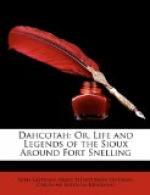U-MI-NE-WAH-CHIPPE;
OR,
TO DANCE AROUND.
I have noticed the many singular notions of the Sioux concerning thunder, and especially the fact that they believe it to be a large bird. They represent it thus. [Illustration:] This figure is often seen worked with porcupine quills on their ornaments. Ke-on means to fly. Thunder is called Wah-ke-on or All-flier. U-mi-ne-wah-chippe is a dance given by some one who fears thunder and thus endeavors to propitiate the god and save his own life.
A ring is made, of about sixty feet in circumference, by sticking saplings in the ground, and bending their tops down, fastening them together. In the centre of this ring a pole is placed. The pole is about fifteen feet in height and painted red. From this swings a piece of birch bark, cut so as to represent thunder. At the foot of the pole stand two boys and two girls.
The two boys represent war: they are painted red, and hold war-clubs in their hands. The girls have their faces painted with blue clay: they represent peace.
On one side of the circle a kind of booth is erected, and about twenty feet from it a wigwam. There are four entrances to this circle.
When all the arrangements for the dance are concluded, the man who gives the dance emerges from his wigwam dressed up as hideously as possible, crawling on all fours towards the booth. He must sing four tunes before reaching it.
In the meantime the medicine men, who are seated in the wigwam, beat time on the drum, and the young men and squaws keep time to the music by first hopping on one foot, and then on the other—moving around inside the ring as fast as they can. This is continued for about five minutes, until the music stops. After resting a few moments, the second tune commences, and lasts the same length of time, then the third, and the fourth; the Indian meanwhile making his way towards the booth. At the end of each tune, a whoop is raised by the men dancers.
After the Indian has reached his booth inside the ring, he must sing four more tunes as before. At the end of the fourth tune the squaws all run out of the ring as fast as possible, and must leave by the same way that they entered, the other three entrances being reserved for the men, who, carrying their war implements, might be accidentally touched by one of the squaws—and the war implements of the Sioux warrior have from time immemorial been held sacred from the touch of woman. For the same reason the men form the inner ring in dancing round the pole, their war implements being placed at the foot of the pole.
When the last tune is ended, the young men shoot at the image of thunder which is hanging to the pole, and when it falls a general rush is made by the warriors to get hold of it. There is placed at the foot of the pole a bowl of water colored with blue clay. While the men are trying to seize the parts of the bark representation of their god, they at the same time are eagerly endeavoring to drink the water in the bowl, every drop of which must be drank.




